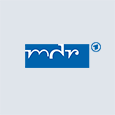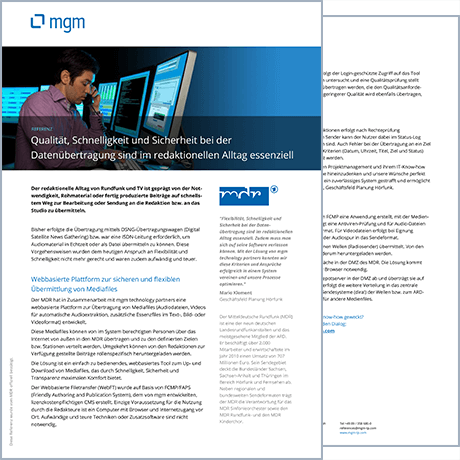The everyday work of editors in radio and TV is characterized by the need to transmit raw material or finished contributions for either editing or broadcasting to the editorial department or studio as fast as possible.
So far, the transmission was facilitated via DSNG (Digital Satellite News Gathering) transmission broadcast vans or an ISDN line was necessary to transmit audio material in real-time or as a file. These approaches did no longer fit the current expectations to flexibility and speed and furthermore, they were too complicated and expensive.
Web-based platform for the secure and flexible transmission of media files
The MDR developed a web-based platform for the transmission of media files (audio files, videos for automatic audio extraction, additional essence files in text, image or video format) in cooperation with mgm technology partners.
These media files can be transmitted by authorized persons via the internet from the outside into the MDR and be distributed to the defined targets or stations, respectively. Conversely, contributions made available by the editorial department can be downloaded controlled by roles.
The solution is an easy to use web-based tool for the up- and download of media files offering maximum comfort through speed, security and transparency.
The web-based file transfer (WebFT) was implemented based on FCMP/FAPS (Friendly Authoring and Publication System), a CMS developed and licensed at a cost by mgm. The only prerequisite for use by the editors is a computer with a browser and an internet connection on location. Complicated and expensive technology or additional software is not necessary.
Comprehensive security architecture
To ensure encryption and authentication, login protected access to the tool is granted via HTTPS. The media files are scanned for viruses during upload and a quality check ensures that only those audio files are transmitted to the broadcast system automatically that conform to the quality requirements of the MDR. Audio with low quality is also transmitted but not processed automatically.
Versatile control tools
After permissions are checked, the media files are distributed to the editorial departments defined by the user fully automated. The user can check the availability of completed and open processes in the status log from the start of the upload until storage in the broadcast center is completed. Errors in the transmission to a target are documented with the respective reasons. The log entries can be sorted by criteria (date, time, title, target and status). The display can also be adapted individually.
“mgm technology partners not only convinced with their professional project management and IT know-how but also with the ability to understand our business and to implement our wishes. The daily editorial workflow was streamlined by a reliable system and allows us flexibility and fast work,” as Mario Klement of the Business Sector Radio Planning sums up.
Technical and functional focus points:
Based on the Java development platform FCMP an application was developed to load media files to a server via HTTPS. It includes an anti-virus check and, for audio files, an automatic conversion into the broadcast format. After a suitability check (check for minimum quality) video files are extracted and their audio track converted to the broadcast format.
The transmitted files are spread to the waves (radio transmitter) specified by the editor. The files provided by the waves can in turn be downloaded by the editors.
The communication level creates a depot server with a web interface in the DMZ of the MDR. The solution does not need special client software, only a modern browser is required.
A further, permanently running process fetches data from the depot server in the DMZ and transmits it to an interface server within the MDR network. They are then distributed from there into the central file transfer system of the MDR (DigAS) (and from there on to the broadcast systems (dira!) of the waves or the ARD file transfer, respectively) for the audio files and into specified handover directories for other media files.
* This reference has been officially confirmed by the MDR.


